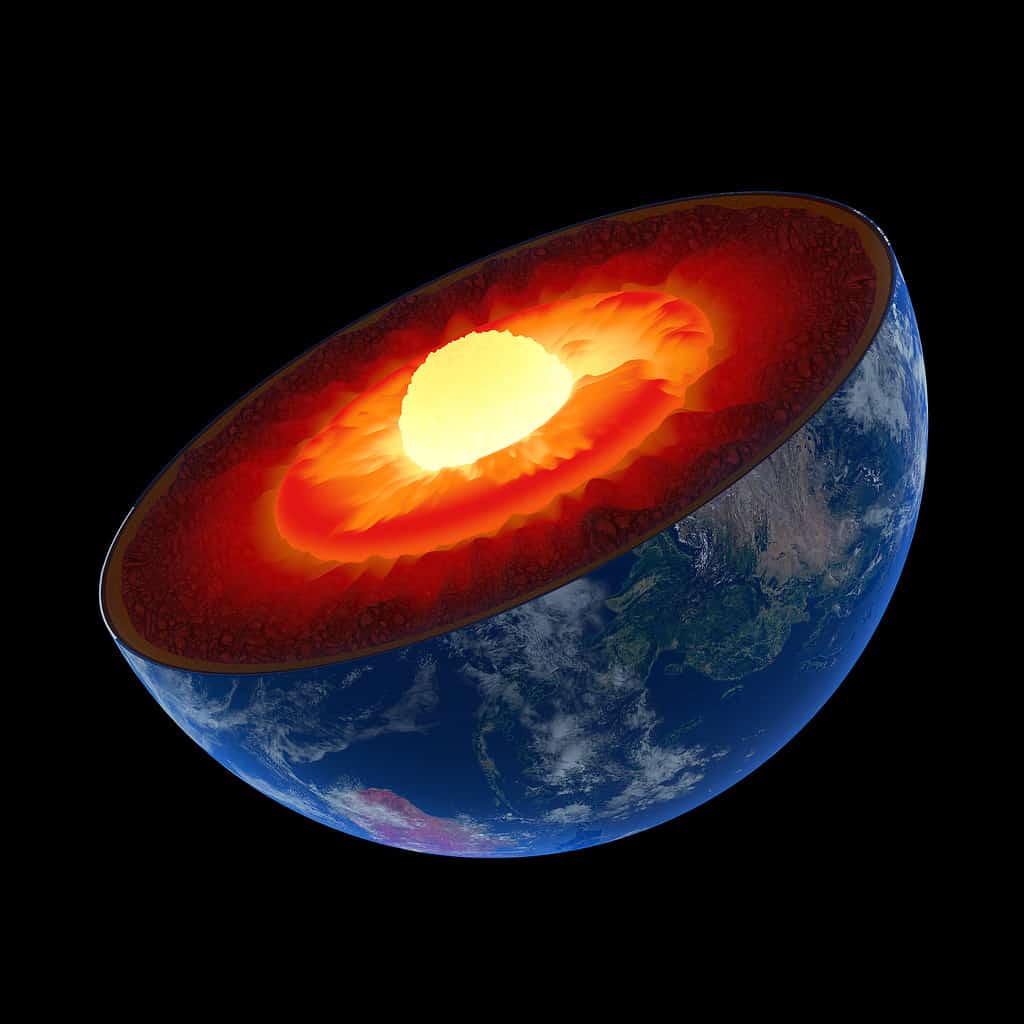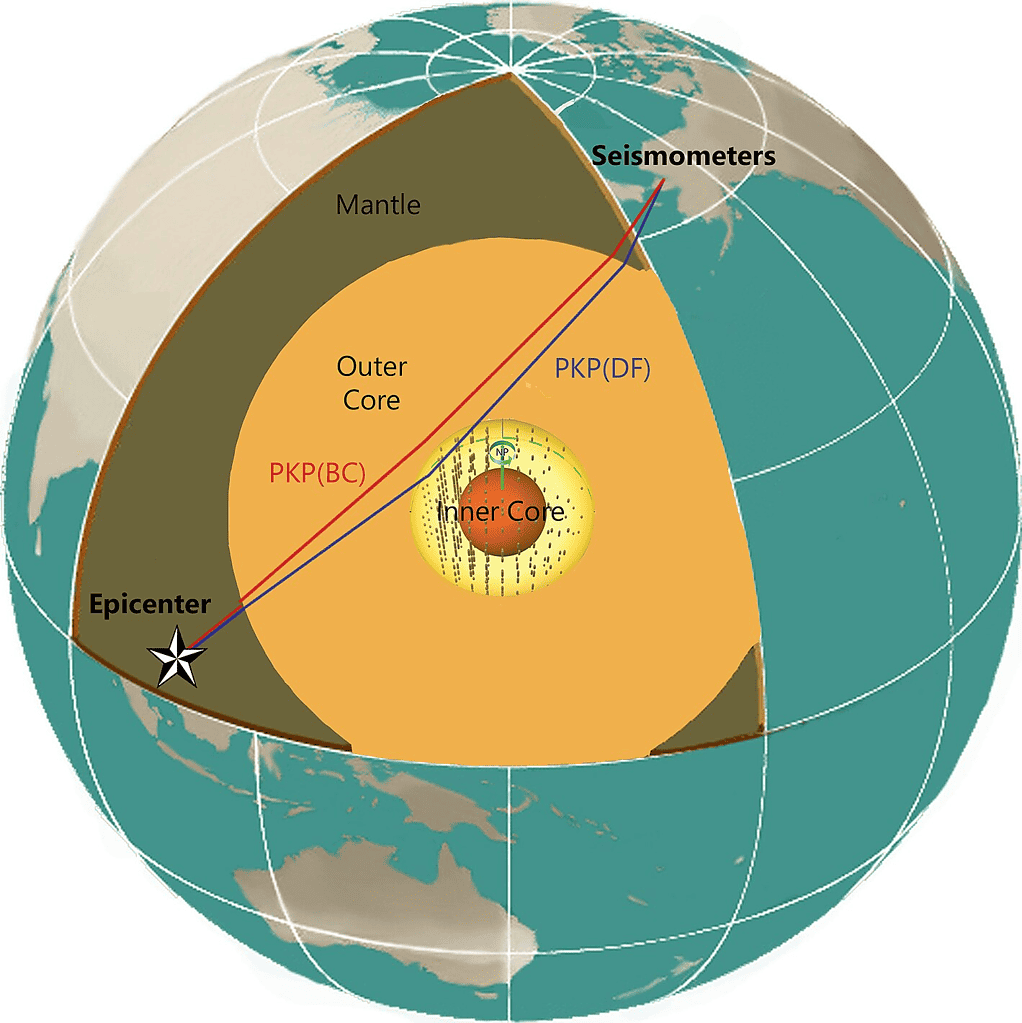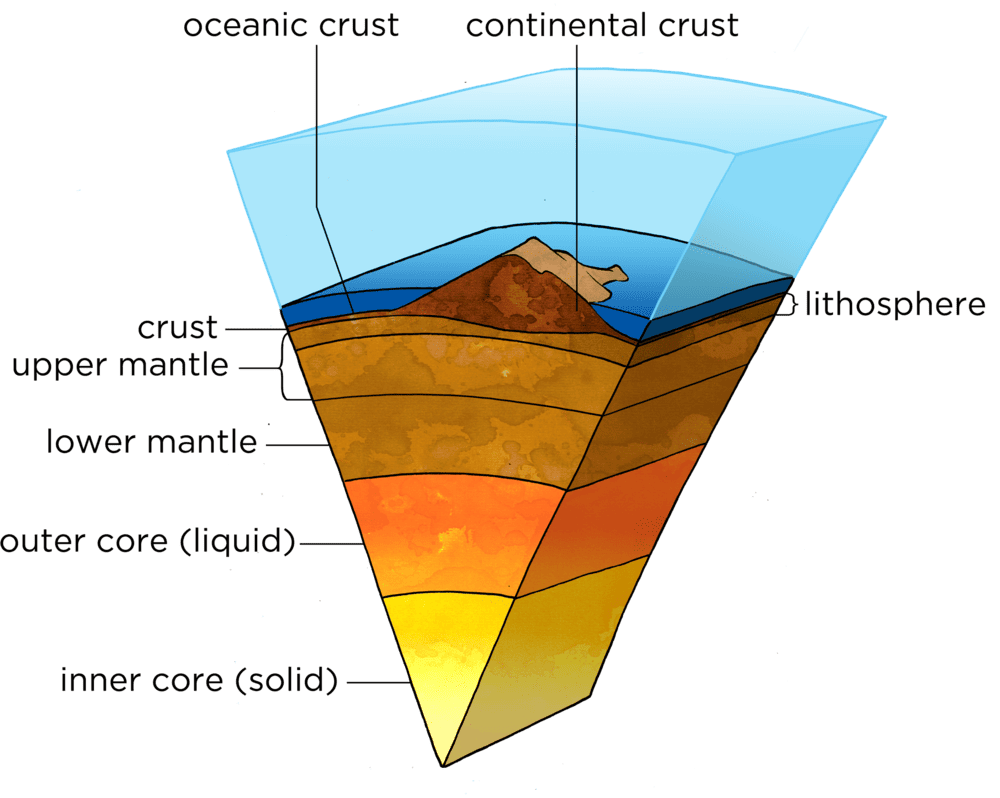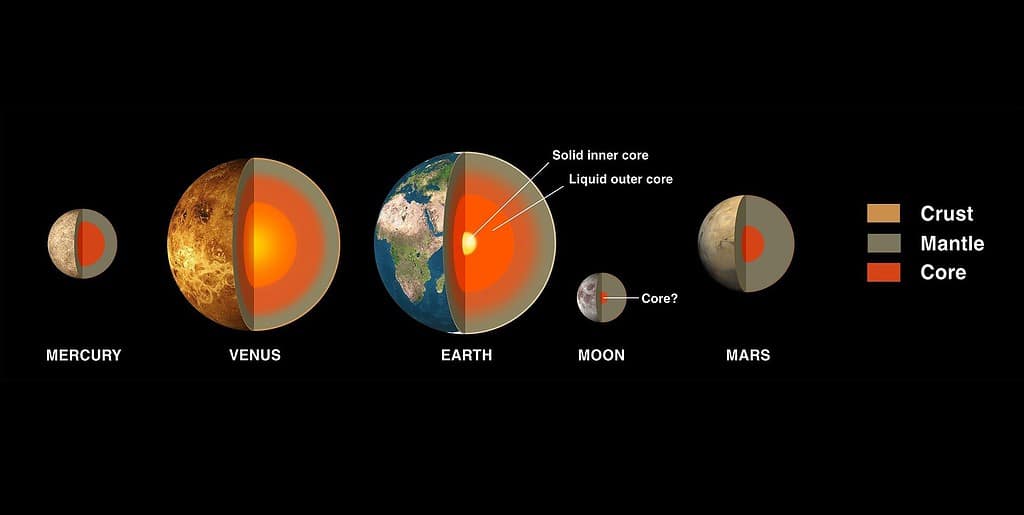
The Earth’s solid inner core is one of the most mysterious places on the planet. It has the most extreme temperature and pressure environment on Earth, with a pressure exceeding 3 million atmospheres and a temperature close to that of the surface of the sun.
At the very heart of our planet, the inner core is a ball of hot, solid iron and nickel. The inner core plays a key role in how our planet rotates and our planet’s magnetic field. Without the inner core, the Earth would be a very different place. Let’s dive in.
Earth’s Inner Core Facts: A Quick Dive
The Earth is layered like an onion, with the inner core at the center, followed by the outer core, the mantle, and finally the crust, which is the part we live on. What’s intriguing is that the inner core is solid — despite temperatures that reach up to about 9,000 to 13,000 degrees Fahrenheit (5,000 to 7,000 degrees Celsius).
You might wonder why it doesn’t melt at those high temperatures. After all, the melting point of iron is much lower. Well, the pressure at the inner core is so immense—about 3.6 million times the pressure at the Earth’s surface—that the iron and nickel are squeezed into a solid state.
The inner core has a radius of about 1,220 kilometers (758 miles). It’s surrounded by the outer core, whose radius is almost three times larger. The reason why geophysicists consider them as separate despite being so similar chemically is the state of matter. The outer core is molten, while the inner core is liquid.
Inner core vs outer core
Understanding the differences between the Earth’s outer core and the inner core is crucial for several reasons, including our understanding of Earth’s magnetic field, seismic activity, and the planet’s overall structure. Here are some of the main differences and their importance:
| Feature | Outer Core | Inner Core |
|---|---|---|
| State of Matter | Liquid | Solid |
| Composition | Iron and Nickel | Iron and Nickel |
| Temperature | 4,000 – 6,100°C (7,200 – 11,000°F) | 5,000 – 7,000°C (9,000 – 12,600°F) |
| Thickness | Approximately 2,300 km (1,400 miles) | Approximately 1,200 km (750 miles) |
| Density | Lower than inner core | Higher than outer core |
| Seismic Activity | S-Waves cannot pass through | Both P-Waves and S-Waves can pass |
| Magnetic Field | Generates Earth’s magnetic field | Does not generate magnetic field |
| Rotational Speed | Rotates at a different speed than the mantle | Rotates at the same speed as the mantle |
The density, temperature, and physical parameters are important for understanding key geological processes in our planet. But it’s the state of matter (the fact that the outer core is liquid and the inner core is solid) that is essential for life on Earth.
The outer core contains molten metal that moves around and generates electric currents, which in turn create the Earth’s magnetic field. The solid inner core is thought to play a stabilizing role in this process, providing around 10% of the planet’s magnetic field (despite accounting for less than 1% of its volume). Without this magnetic field, our planet would be exposed to devastating solar radiation — and life as we know it couldn’t exist.
Yep, we probably owe our very existence to the core of the Earth that works as a dynamo — a geodynamo.
The Journey Down: How Do We Know?
You might be wondering, “How on Earth (pun intended) do scientists know what’s happening so deep underground?” The answer is both simple and elegant: earthquakes.

When an earthquake strikes, it sends seismic waves rippling through our planet. Like an X-ray revealing the bones inside your body, these waves give scientists a glimpse into the Earth’s interior. By observing how these waves change speed or get absorbed as they travel, researchers have mapped the various layers below. It’s like a planetary game of “echolocation,” and Earth’s deep rumbles are the starting point.
Remember how we said that S waves don’t pass through the outer core but they pass through the inner core (in the table above)? Well, S waves are a type of seismic wave. They are sometimes also called shearing waves. S waves don’t pass through molten materials — so if they pass through the inner core, we know the inner core isn’t liquid.
Meanwhile, P waves or Primary waves pass through both molten and solid layers of the Earth, but they can help us determine other parameters like density and chemical composition.
Still Much To Learn About Earth’s Inner Core
Virtually all we know about the inner core comes from earthquakes. But more recently, researchers have found ways to simulate the ungodly conditions in the core in laboratories. By creating conditions akin to the center of the Earth inside a laboratory chamber, researchers believe they know how old the inner core is — 1 billion to 1.3 billion years old.

Additionally, the studies and related theories provide insights into how well the Earth’s core transfers heat, and the energy sources driving our planet’s geodynamo.
“People are really curious and excited about knowing about the origin of the geodynamo, the strength of the magnetic field, because they all contribute to a planet’s habitability,” said Jung-Fu Lin, a professor at The University of Texas at Austin’s Jackson School of Geosciences who led the research.
“Once you actually know how much of that heat flux from the outer core to the lower mantle, you can actually think about when did the Earth cool sufficiently to the point that the inner core starts to crystalize,” he said.

For all we’ve learned about the inner core, countless questions remain. Some scientists believe that the core might have its own “mountains” and “valleys.” Others postulate that it might not be as uniformly solid as we think, with pockets of liquid peppered throughout.
Guanning Pang, a former Ph.D. student in the University of Utah’s Department of Geology and Geophysics conducted a study that showed such inhomogeneities in this solid metal ball. “For the first time we confirmed that this kind of inhomogeneity is everywhere inside the inner core,” Pang said.
“What our study was about was trying to look inside the inner core,” said university seismologist Keith Koper, who oversaw the study. “It’s like a frontier area. Anytime you want to image the interior of something, you have to strip away the shallow effects. So this is the hardest place to make images, the deepest part, and there are still things that are unknown about it.”
The fact that at this hellish pressure and temperature, you can still have some inhomogeneities is stunning and shows just how much we don’t know about the inner core.
Another surprising study led by Youjun Zhang, a professor at Sichuan University found that at least in one way, the inner core is a bit like butter.
“Seismologists have found that the center of the Earth, called the inner core, is surprisingly soft, kind of like how butter is soft in your kitchen,” he said. “The big discovery that we’ve found is that solid iron becomes surprisingly soft deep inside the Earth because its atoms can move much more than we ever imagined. This increased movement makes the inner core less rigid, weaker against shear forces.”
In Closing: Earth’s Hidden Heartbeat

There’s a lot we don’t know about the planet’s crust — and we can see it every day. When it comes to the planet’s core, there’s just a lot left to be discovered, but researchers are making steady progress.
Your understanding of the Earth’s inner sanctum is evolving. As you stand on this ever-changing planet, take a moment to marvel at the secrets beneath your feet. With each new discovery, you’re not just learning about the ground below. You’re unraveling the story of your home, one seismic wave at a time.






